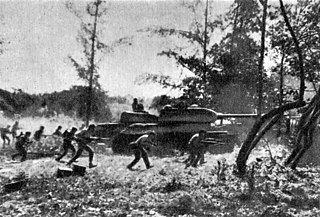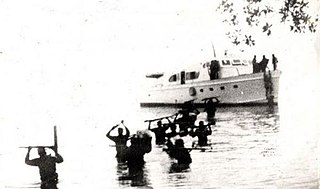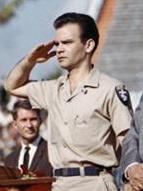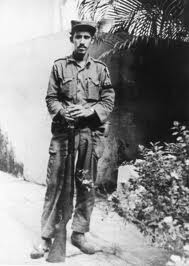
The Bay of Pigs is an inlet of the Gulf of Cazones located on the southern coast of Cuba. By 1910, it was included in Santa Clara Province, and then instead to Las Villas Province by 1961, but in 1976, it was reassigned to Matanzas Province, when the original six provinces of Cuba were re-organized into 14 new Provinces of Cuba.

The Bay of Pigs Invasion was a failed military landing operation on the southwestern coast of Cuba in 1961 by Cuban Democratic Revolutionary Front (DRF), consisting of Cuban exiles who opposed Fidel Castro's Cuban Revolution, clandestinely financed and directed by the U.S. government. The operation took place at the height of the Cold War, and its failure influenced relations between Cuba, the United States, and the Soviet Union.

Granma is a yacht that was used to transport 82 fighters of the Cuban Revolution from Mexico to Cuba in November 1956 to overthrow the regime of Fulgencio Batista. The 60-foot diesel-powered vessel was built in 1943 by Wheeler Shipbuilding of Brooklyn, New York, as a light armored target practice boat, US Navy C-1994, and modified postwar to accommodate 12 people. "Granma", in English, is an affectionate term for a grandmother; the yacht is said to have been named for the previous owner's grandmother.

Félix Ismael Rodríguez Mendigutia is a Cuban American former Central Intelligence Agency Paramilitary Operations Officer in the Special Activities Division, known for his involvement in the Bay of Pigs Invasion and the execution of communist revolutionary Che Guevara as well as his close ties to George H. W. Bush during the Iran–Contra affair.

Arnaldo Tomás Ochoa Sánchez was a Cuban general who was executed by the government of Fidel Castro after being found guilty of a variety of crimes including drug smuggling and treason.

Manuel Francisco Artime Buesa, M.D. was a Cuban-American who at one time was a member of the rebel army of Fidel Castro but later was the political leader of Brigade 2506 land forces in the abortive Bay of Pigs invasion of Cuba in April 1961.

Huber Matos Benítez was a Cuban military leader, political dissident, activist, and writer. He opposed the dictatorship of Fulgencio Batista from its inception in 1952 and fought alongside Fidel Castro, Raul Castro, Che Guevara, Camilo Cienfuegos and other members of the 26th of July Movement to overthrow it. Following the success of the Cuban Revolution that brought Fidel Castro to power, he criticized the regime's shift in favor of Marxist principles and ties to the Popular Socialist Party (PSP). Convicted of treason and sedition by the revolutionary government, he spent 20 years in prison (1959–1979) before being released in 1979. He then divided his time between Miami, Florida, and Costa Rica while continuing to protest the policies of the Cuban government.
Rafael del Pino is a former Cuban General of the Air Force and political dissident who defected to the United States by flying a civilian airplane from Cuba to Key West, Florida.
Operation 40 was the code name for a Central Intelligence Agency-sponsored counterintelligence group composed of Cuban exiles. The group was formed to seize control of the Cuban government after the Bay of Pigs Invasion. Operation 40 continued to operate unofficially until disbanded in 1970 due to allegations that an aircraft that was carrying cocaine and heroin in support of the group crashed in California.

José Ramón Fernández Álvarez was a Cuban Communist leader who was a vice-president of the Council of Ministers.
Erneido Andres Oliva Gonzalez was a Cuban-American who was the deputy commander of Brigade 2506 land forces in the abortive Bay of Pigs Invasion of Cuba in April 1961.

The Bay of Pigs Museum, also known as the Brigade 2506 Museum and Library, is the official museum in memory of the Bay of Pigs Invasion's Brigade 2506 in Little Havana, Miami, Florida.

José Alfredo Pérez San Román, known as Pepe San Román, was the commander of Brigade 2506 ground troops in the Bay of Pigs Invasion of Cuba in April 1961. Pérez was his father's last name.

Efigenio Ameijeiras Delgado was a Cuban military commander affiliated with Fidel Castro from the 1950s. Son of Manuel Ameijeiras Fontelo, a native of Pontevedra (Spain) and the Cuban María de las Angustias Delgado Romo, from Corral Falso, in Matanzas. At the age of four, his father disappeared, so his mother had to take care of her children alone.
Ricardo Miguel Montero Duque is a Cuban exile who was a military battalion commander in the invading forces of Brigade 2506 during the Bay of Pigs Invasion of Cuba in April 1961.
Gerard "Gerry" Droller was a German CIA officer involved in the covert 1954 Guatemalan coup d'état and the recruitment of Cuban exiles in the preparation of the Bay of Pigs Invasion in April 1961.

Jack L. Hawkins was a United States Marines Corps colonel employed by the CIA for the military planning, training of Cuban exiles, and the effective military command of forces in the Bay of Pigs Invasion of Cuba in April 1961. Hawkins was known by the alias John Haskins.
Alfredo Joaquin González Durán is a Cuban-born lawyer and an advocate for dialogue as a way to bring regime change in Cuba. His views are considered controversial in some parts of the Cuban exile community in Miami.
Victor Andres Triay is a Cuban American historian and writer, known for the books Fleeing Castro: Operation Pedro Pan and the Cuban Children’s Program, Bay of Pigs: An Oral History of Brigade 2506, The Unbroken Circle, and The Mariel Boatlift: A Cuban American Journey.
Juan Jose Peruyero was a Cuban exile and anti-communist activist. He took part in the Bay of Pigs Invasion in 1961, and he later served as the president of its veteran association in Miami, Florida, where he was assassinated in 1977. He is the namesake of the Juan J. Peruyero Museum and Manuel F. Artime Library in Miami, also known as the Bay of Pigs Museum.













